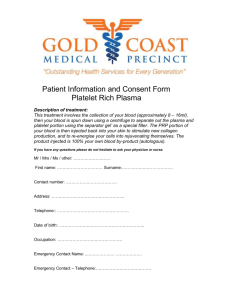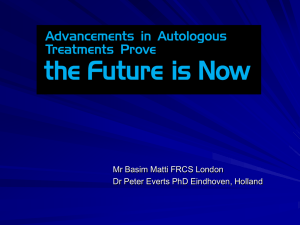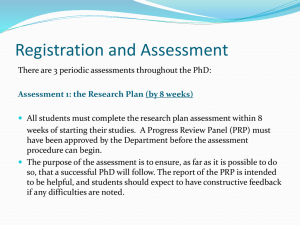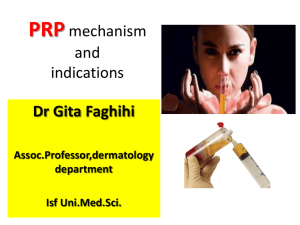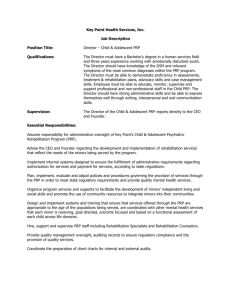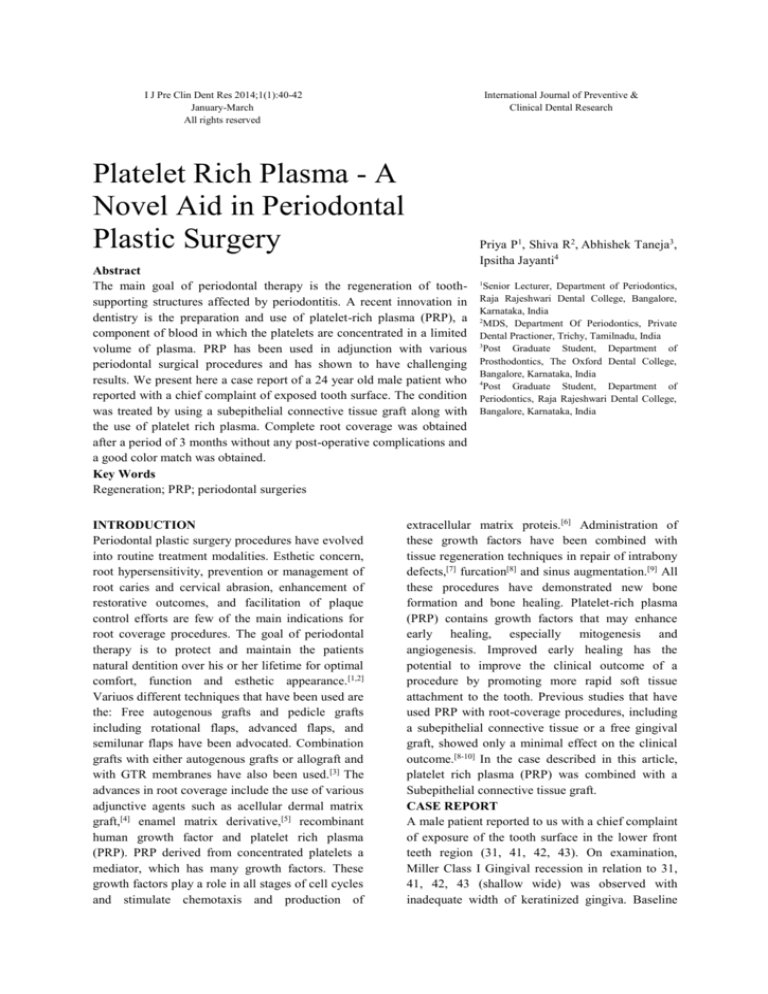
I J Pre Clin Dent Res 2014;1(1):40-42
January-March
All rights reserved
International Journal of Preventive &
Clinical Dental Research
Platelet Rich Plasma - A
Novel Aid in Periodontal
Plastic Surgery
Priya P1, Shiva R2, Abhishek Taneja3,
Ipsitha Jayanti4
Abstract
The main goal of periodontal therapy is the regeneration of toothsupporting structures affected by periodontitis. A recent innovation in
dentistry is the preparation and use of platelet-rich plasma (PRP), a
component of blood in which the platelets are concentrated in a limited
volume of plasma. PRP has been used in adjunction with various
periodontal surgical procedures and has shown to have challenging
results. We present here a case report of a 24 year old male patient who
reported with a chief complaint of exposed tooth surface. The condition
was treated by using a subepithelial connective tissue graft along with
the use of platelet rich plasma. Complete root coverage was obtained
after a period of 3 months without any post-operative complications and
a good color match was obtained.
Key Words
Regeneration; PRP; periodontal surgeries
INTRODUCTION
Periodontal plastic surgery procedures have evolved
into routine treatment modalities. Esthetic concern,
root hypersensitivity, prevention or management of
root caries and cervical abrasion, enhancement of
restorative outcomes, and facilitation of plaque
control efforts are few of the main indications for
root coverage procedures. The goal of periodontal
therapy is to protect and maintain the patients
natural dentition over his or her lifetime for optimal
comfort, function and esthetic appearance.[1,2]
Variuos different techniques that have been used are
the: Free autogenous grafts and pedicle grafts
including rotational flaps, advanced flaps, and
semilunar flaps have been advocated. Combination
grafts with either autogenous grafts or allograft and
with GTR membranes have also been used.[3] The
advances in root coverage include the use of various
adjunctive agents such as acellular dermal matrix
graft,[4] enamel matrix derivative,[5] recombinant
human growth factor and platelet rich plasma
(PRP). PRP derived from concentrated platelets a
mediator, which has many growth factors. These
growth factors play a role in all stages of cell cycles
and stimulate chemotaxis and production of
1
Senior Lecturer, Department of Periodontics,
Raja Rajeshwari Dental College, Bangalore,
Karnataka, India
2
MDS, Department Of Periodontics, Private
Dental Practioner, Trichy, Tamilnadu, India
3
Post Graduate Student, Department of
Prosthodontics, The Oxford Dental College,
Bangalore, Karnataka, India
4
Post Graduate Student, Department of
Periodontics, Raja Rajeshwari Dental College,
Bangalore, Karnataka, India
extracellular matrix proteis.[6] Administration of
these growth factors have been combined with
tissue regeneration techniques in repair of intrabony
defects,[7] furcation[8] and sinus augmentation.[9] All
these procedures have demonstrated new bone
formation and bone healing. Platelet-rich plasma
(PRP) contains growth factors that may enhance
early healing, especially mitogenesis and
angiogenesis. Improved early healing has the
potential to improve the clinical outcome of a
procedure by promoting more rapid soft tissue
attachment to the tooth. Previous studies that have
used PRP with root-coverage procedures, including
a subepithelial connective tissue or a free gingival
graft, showed only a minimal effect on the clinical
outcome.[8-10] In the case described in this article,
platelet rich plasma (PRP) was combined with a
Subepithelial connective tissue graft.
CASE REPORT
A male patient reported to us with a chief complaint
of exposure of the tooth surface in the lower front
teeth region (31, 41, 42, 43). On examination,
Miller Class I Gingival recession in relation to 31,
41, 42, 43 (shallow wide) was observed with
inadequate width of keratinized gingiva. Baseline
41
Platelet Rich Plasma
Priya P, Shiva R, Taneja A, Jayanti I
Fig. 1: Pre-Operative View
Fig. 2: Armamentarium Used
Fig. 3: Preparation of Recipient
Site
Fig. 4: Reflection of Partial
Thickness Flap
Fig. 5: Procurement of Graft
From Donor Site
Fig. 6: Application of PRP
Fig. 7: Stabilization of Graft
Fig. 8: Complete Coverage of
the Graft
width was approximately 2-3mm and the recession
depth was about 2-3mm. A thorough scaling and
root planing was carried out and the patient was
recalled for further evaluation. On the subsequent
visit a sub-epithelial connective tissue graft
procedure along with the use of PRP was planned to
obtain the optimal root coverage in the affected
area.
PREPARATION OF PRP
One hour before the surgery, 10 ml of blood was
drawn from the antecubital vein into the vacutainers
containing 3.2% anticoagulant sodium citrate. To
separate and concentrate platelets, two separate
centrifugations were done. In the first, the blood
was centrifuged at 2000 rpm for 2 min which
separated the red blood cells from the rest of the
whole blood (white blood cells, Platelets and
Plasma) with a thin white line in between (called as
buffy coat), which has maximum concentration of
platelets. The plasma and the buffy coat were
pipetted out in a separate test tube and centrifuged
at 4000 rpm for 8 min. The second spin resulted in
two separate fragments. The bottom layer was the
Fig. 9: 6 Months PostOperative View
PRP which was overlaid by supernatant fluid
platelet poor plasma (PPP). PPP is pipetted out in a
separate test tube. The PRP is then used for the
procedure. PRP was obtained by the modified
method of Curasan.
SURGICAL PROCEDURE
The recipient site was prepared and a partial
thickness flap was elevated. The donor site was
selected and prepared. A sub-epithelial connective
tissue graft was obtained from the palatal surface of
23, 24, 25 region. The recipient site was covered
with PRP membrane along with the sub-epithelial
connective tissue graft. The donor as well as the
recipient site was covered with periodontal pack and
the patient was advised to follow the post-operative
instructions. Wound healing was uneventful both at
the recipient and donor site without any postoperative complications. Complete root coverage
was obtained after a period of 6 months.
DISCUSSION
The goal of periodontal therapy is to protect and
maintain the patients natural dentition over his or
her lifetime for optimal comfort, function and
42
Platelet Rich Plasma
esthetic appearance. Along with root coverage it is
necessary to achieve an increased zone of
keratinized gingival also. PRP is rich in growth
factors and helps in soft‑tissue healing, initial clot
stabilization and revascularization of the flaps and
grafts in root coverage procedures.[8] PRP acts as a
scaffold when used along with bone graft. The
placement of PRP on a recession defect is difficult
so it is usually used in adjunction with carrier such
as collagen sponge or other graft materials.[9] In the
present study, PRP was used along with a subepithelial connective tissue graft. During one week
post-operative examination, the gingival appearance
was evaluated and it was nearly normal in
appearance ranging between no gingival erythema
or edema to a slight erythema and edema. This
shows an accelerated soft-tissue healing. The
presence of growth factors in PRP such as platelet
derived growth factor (PDGF), transforming growth
factor β (TGF‑β) and vascular endothelial growth
factor (VEGF) enhance soft‑tissue healing by
hastening the angiogenesis and matrix biosynthesis
during early wound healing.[10] In the present case a
successful outcome was obtained by using PRP
along with sub epithelial connective tissue graft for
root coverage procedure with no significant postoperative complications.
CONCLUSION
PRP is a new application of tissue engineering.
Although the growth factors and the mechanisms
involved are still poorly understood, the ease of
applying PRP in the dental clinic and its beneficial
outcomes, including reduction of bleeding and rapid
healing, holds promise for further procedures. PRP
may become a routine treatment modality for
periodontal regeneration in future because of its
added advantages.
REFERENCES
1. Zander HA, Polson AM, Heijl LC. Goals of
periodontal
therapy.
J
Periodontol.
1976;47:261-6.
2. Carranza FA, McLain PK, Schallhorn RG.
Regenerative osseous surgery. Clinical
Periodontology. 9th ed. 2002. p. 804-24.
3. Pin Prato GP, Tinti C, Vincenz G, Magnani C,
Cortellini P, Clauser C. Guided tissue
regeneration versus mucogingival surgery in
the treatment of human buccal gingival
recession. J Periodontol. 1992;63:919-28.
4. Lynch SE. The role of growth factors in
periodontal repair and regeneration. In: Polson
AM, editor. Periodontal Regeneration: Current
Priya P, Shiva R, Taneja A, Jayanti I
Status and Directions. St. Louis: Quintessence
Publishing Co, Inc.; 1994. p. 179‑98.
5. Camargo PM, Lekovic V, Weinlaender M,
Vasilic N, Madzarevic M, Kenney EB. Platelet
‑rich plasma and bovine porous bone mineral
combined with guided tissue regeneration in
the treatment of intrabony defects in humans. J
Periodontal Res. 2002;37:300‑6.
6. Lekovic V, Camargo PM, Weinlaender M,
Vasilic N, Aleksic Z, Kenney EB.
Effectiveness of a combination of platelet‑rich
plasma, bovine porous bone mineral and
guided tissue regeneration in the treatment of
mandibular grade II molar furcations in
humans. J Clin Periodontol. 2003;30:746‑51.
7. Froum SJ, Wallace SS, Tarnow DP, Cho SC.
Effect of platelet‑rich plasma on bone growth
and osseointegration in human maxillary sinus
grafts: Three bilateral case reports. Int J
Periodontics Restorative Dent. 2002;22:45‑53.
8. Huang LH, Neiva REF, Soehren SE,
Giannobile WV, Wang HL. The effect of
platelet-rich plasma on the coronally advanced
flap root coverage procedure: A pilot human
trial. J Periodontol. 2005;76:1768-1777.
9. Cheung WS, Griffin TJ. A comparative study
of root coverage with connective tissue and
platelet concentrate grafts: 8-month results. J
Periodontol. 2004;75:1678-1687.
10. Keceli HG, Sengun D, Berberoglu A,
Karabulut E. Use of platelet gel with
connective tissue grafts for root coverage: A
randomized-controlled
trial.
J
Clin
Periodontol. 2008;35:255-262.

